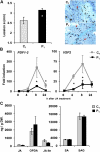Next-generation systemic acquired resistance
- PMID: 22147520
- PMCID: PMC3271772
- DOI: 10.1104/pp.111.187468
Next-generation systemic acquired resistance
Abstract
Systemic acquired resistance (SAR) is a plant immune response to pathogen attack. Recent evidence suggests that plant immunity involves regulation by chromatin remodeling and DNA methylation. We investigated whether SAR can be inherited epigenetically following disease pressure by Pseudomonas syringae pv tomato DC3000 (PstDC3000). Compared to progeny from control-treated Arabidopsis (Arabidopsis thaliana; C(1)), progeny from PstDC3000-inoculated Arabidopsis (P(1)) were primed to activate salicylic acid (SA)-inducible defense genes and were more resistant to the (hemi)biotrophic pathogens Hyaloperonospora arabidopsidis and PstDC3000. This transgenerational SAR was sustained over one stress-free generation, indicating an epigenetic basis of the phenomenon. Furthermore, P(1) progeny displayed reduced responsiveness of jasmonic acid (JA)-inducible genes and enhanced susceptibility to the necrotrophic fungus Alternaria brassicicola. This shift in SA- and JA-dependent gene responsiveness was not associated with changes in corresponding hormone levels. Instead, chromatin immunoprecipitation analyses revealed that SA-inducible promoters of PATHOGENESIS-RELATED GENE1, WRKY6, and WRKY53 in P(1) plants are enriched with acetylated histone H3 at lysine 9, a chromatin mark associated with a permissive state of transcription. Conversely, the JA-inducible promoter of PLANT DEFENSIN1.2 showed increased H3 triple methylation at lysine 27, a mark related to repressed gene transcription. P(1) progeny from the defense regulatory mutant non expressor of PR1 (npr1)-1 failed to develop transgenerational defense phenotypes, demonstrating a critical role for NPR1 in expression of transgenerational SAR. Furthermore, the drm1drm2cmt3 mutant that is affected in non-CpG DNA methylation mimicked the transgenerational SAR phenotype. Since PstDC3000 induces DNA hypomethylation in Arabidopsis, our results suggest that transgenerational SAR is transmitted by hypomethylated genes that direct priming of SA-dependent defenses in the following generations.
Figures





Comment in
-
Prime time for transgenerational defense.Plant Physiol. 2012 Feb;158(2):545. doi: 10.1104/pp.112.900430. Plant Physiol. 2012. PMID: 22308198 Free PMC article. No abstract available.
Similar articles
-
The role of DNA (de)methylation in immune responsiveness of Arabidopsis.Plant J. 2016 Nov;88(3):361-374. doi: 10.1111/tpj.13252. Epub 2016 Sep 7. Plant J. 2016. PMID: 27341062 Free PMC article.
-
Ethylene and jasmonic acid signaling affect the NPR1-independent expression of defense genes without impacting resistance to Pseudomonas syringae and Peronospora parasitica in the Arabidopsis ssi1 mutant.Mol Plant Microbe Interact. 2003 Jul;16(7):588-99. doi: 10.1094/MPMI.2003.16.7.588. Mol Plant Microbe Interact. 2003. PMID: 12848424
-
The epigenetic machinery controlling transgenerational systemic acquired resistance.Plant Signal Behav. 2012 Jun;7(6):615-8. doi: 10.4161/psb.20155. Epub 2012 May 14. Plant Signal Behav. 2012. PMID: 22580690 Free PMC article.
-
Enhancement of broad-spectrum disease resistance in wheat through key genes involved in systemic acquired resistance.Front Plant Sci. 2024 Feb 23;15:1355178. doi: 10.3389/fpls.2024.1355178. eCollection 2024. Front Plant Sci. 2024. PMID: 38463563 Free PMC article. Review.
-
Chemical priming of plant defense responses to pathogen attacks.Front Plant Sci. 2023 May 8;14:1146577. doi: 10.3389/fpls.2023.1146577. eCollection 2023. Front Plant Sci. 2023. PMID: 37223806 Free PMC article. Review.
Cited by
-
Mythimna separata herbivory primes maize resistance in systemic leaves.J Exp Bot. 2021 May 4;72(10):3792-3805. doi: 10.1093/jxb/erab083. J Exp Bot. 2021. PMID: 33647931 Free PMC article.
-
Small RNAs--the secret agents in the plant-pathogen interactions.Curr Opin Plant Biol. 2015 Aug;26:87-94. doi: 10.1016/j.pbi.2015.05.033. Epub 2015 Jun 26. Curr Opin Plant Biol. 2015. PMID: 26123395 Free PMC article. Review.
-
Plant innate immunity: an updated insight into defense mechanism.J Biosci. 2013 Jun;38(2):433-49. doi: 10.1007/s12038-013-9302-2. J Biosci. 2013. PMID: 23660678 Review.
-
Changes of phenolic secondary metabolite profiles in the reaction of narrow leaf lupin (Lupinus angustifolius) plants to infections with Colletotrichum lupini fungus or treatment with its toxin.Metabolomics. 2013 Jun;9(3):575-589. doi: 10.1007/s11306-012-0475-8. Epub 2012 Oct 30. Metabolomics. 2013. PMID: 23678343 Free PMC article.
-
Plant immune responses against viruses: how does a virus cause disease?Plant Cell. 2013 May;25(5):1489-505. doi: 10.1105/tpc.113.111658. Epub 2013 May 24. Plant Cell. 2013. PMID: 23709626 Free PMC article. Review.
References
-
- Baulcombe D, Crute I, Davies B, Dunwell J, Gale M, Jones J, Pretty J, Sutherland W, Toumin C. (2009) Reaping the benefits: science and the sustainable intensification of global agriculture. In Royal Society, RS Policy Document 11/09. Royal Society, London, 2009
-
- Brodersen P, Voinnet O. (2006) The diversity of RNA silencing pathways in plants. Trends Genet 22: 268–280 - PubMed
Publication types
MeSH terms
Grants and funding
LinkOut - more resources
Full Text Sources
Other Literature Sources
Molecular Biology Databases
Miscellaneous

